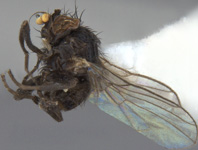Abstract
Re-assessment of spionid specimens from Iberian Peninsula initially assigned to Dispio uncinata Hartman, 1951 and Streblospio benedicti Webster, 1879 led to the recognition of two new species from the spionid genera Dispio and Streblospio from coasts around the Iberian Peninsula. Dispio elegans sp. nov. is characterised by having an oblanceolate-shaped prostomium. In addition, the first two notopodial postchaetal lamellae are serrated with digitiform papillae, the anterior neuropodial lamellae are smooth; all branchiae are almost completely fused to the notopodial lamellae, but with the tips free; the notochaetae on chaetiger 1 are smooth, alimbate capillaries; the ventral chaetae located in the position of the sabre chaetae on chaetigers 1–2 are smooth, alimbate capillaries, but becoming granulated on chaetiger 3; and the middle and posterior chaetigers are granulated and reticulated. Streblospio padventralis sp. nov. is characterized by lacking dorsal papillae between the branchiae of chaetiger 1; the hooks have 4–5 pairs of small teeth; sabre chaetae are present from chaetiger 3; the pygidium has two ventral lappets; and brooding structures are present in the coelomic cavities. We suggest raising the status of Streblospio benedicti japonica Imajima, 1990 to full species level as S. japonica Imajima, 1990. A key for Streblospio species is provided.
References
Blake, J.A. (1983) Polychaetes of the family Spionidae from South America, Antarctica and adjacent seas and islands. In: Kornicker, L. (Ed.), Biology of The Antarctic Seas. Vol. 14. Antarctic Research Series 39. American Geophysical Union, Washington, D.C., pp. 205–287.
https://doi.org/10.1029/AR039p0205Blake, J.A. & Kudenov, J.D. (1978) The Spionidae (Polychaeta) from southeastern Australia and adjacent areas with a revision of the genera. Memoirs of the National Museum of Victoria, 39, 171–280.
https://doi.org/10.24199/j.mmv.1978.39.11Buchanan, F. (1890) Hekaterobranchus shrubsolii, a new genus and species of the family Spionidae. Quarterly Journal of Microscopical Science, London, 31, 175–200.
Coleman, C.O. (2006) Substituting time-consuming pencil drawings in arthropod taxonomy using stacks of digital photographs. Zootaxa, 1360, 61–68.
Day, J.H. (1955) The Polychaeta of South Africa. Part 3. Sedentary species from Cape shores and estuaries. Journal of the Linnean Society of London, 42, 407–452.
https://doi.org/10.1111/j.1096-3642.1955.tb02216.xDelgado-Blas, V.H. & Díaz-Díaz, O. (2016) Redescription of two species and five new species of Dispio Hartman, 1951 (Spionidae: Polychaeta) from the eastern Pacific Coast and Caribbean Sea, with a review of the genus. Zootaxa, 4178 (2), 151–181.
https://doi.org/10.11646/zootaxa.4178.2.1Fiege, D. & Wehe, T. (2004) Type catalogue of the Annelida: Polychaeta in the collections of the Senckenberg-Museum in Frankfurt am Main, Germany. Senckenbergiana biologica, 84, 27–43.
Foster, N.M. (1971) Spionidae (Polychaeta) of the Gulf of Mexico and the Caribbean Sea. Studies on the Fauna of Curaçao and other Caribbean Islands, 36, 1–183.
Friedrich, H. (1956) Mitteilungen über neue und wenig bekannte Polychaeten aus Mittel- und Sud-Amerika. Senekenbergiana biologica, 37, 57–68.
Gibbs, P.E. (1971) The polychaete fauna of the Solomon Islands. Bulletin of the British Museum (Natural History) Zoology, 21, 101–211.
https://doi.org/10.5962/bhl.part.10154Gómez, J.J. & San Martín, G. (1985) Estudio faunístico-ecológico de las taxocenosis de Poliquetos y Moluscos de la playa de Ribeira (Asturias). Boletín del Instituto Español de Oceanografía, 2, 111–118.
Hartman, O. (1951) The littoral marine annelids of the Gulf of Mexico. Publications of the Institute of Marine Science, University of Texas, 2, 7–124.
Ibáñez, M. & Viéitez, J.M. (1973) Presencia en la costa Cantábrica española de Dispio uncinata; contribución a su estudio sistemático y ecológico. Boletín de la Real Sociedad Española de Historia Natural, Biología, 71, 5–8.
Ibáñez, M., Romero, A., Feliu, J., Borja, A., Altuna, A. & Aguirrezabalaga, F. (1984) Consideraciones sobre la biogeografía de la costa vasca. Actas IV Simposio Ibérico de Estudos do Bentos Marinho. Lisboa, 1, 47–56.
Imajima, M. (1990) Spionidae (Annelida, Polychaeta) from Japan, 5. The genera Streblospio and Dispio. Bulletin of the National Science Museum, Series A, Zoology, 16, 155–163
Junoy, J. & Viéitez, J.M. (1990). Macrozoobenthic community structure in the Ría de Foz, an intertidal estuary (Galicia, Northwest Spain). Marine Biology, 107, 329–339.
https://doi.org/10.1007/BF01319833Junoy, J., Castellanos, C., Viéitez, J.M., de la Huz, M.R. & Lastra, M. (2005) The macroinfauna of the galician sandy beaches (NW Spain) affected by the Prestige oil- spill. Marine Pollution Bulletin, 50, 526–536.
https://doi.org/10.1016/j.marpolbul.2004.11.044Laborda, A.J. & Viéitez, J.M. (1984) Anélidos poliquetos intermareales endémicos de Galicia (con la descripción de una nueva especie del género Nephtys). Cuadernos Marisqueros Publicaciones Técnicas, 7, 207–221.
López Serrano, L. (1999) Estudio de la macrofauna bentónica de la desembocadura del Río Piedras (Huelva). Tesis doctoral, Universidad Complutense, Madrid, 438 pp.
Meiβner,K., Bick,A.,Guggohz, T. & Götting, M. (2014) Spionidae (Polychaeta: Canalipalpata: Spionidae) from seamounts in the NE Atlantic. Zootaxa, 3786 (3), 201 –245.
https://doi.org/10.11646/zootaxa.3786.3.1Pettibone, M.H. (1963) Revision of some genera of polychaete worms of the family Spionidae, including the description of a new species of Scolelepis. Proceedings of the Biological Society of Washington, 76, 89–104.
Quintino, V., Rodrigues, A.M., Gentil, F. & Peneda, M.C. (1987) Macrozoobenthic community structure in the Lagoon of Albufeira, western of Portugal. Journal of Experimental Marine Biology and Ecology, 106, 229–241.
https://doi.org/10.1016/0022-0981(87)90095-5Rice, S.A. & Levin, L.A. (1998) Streblospio gynobranchiata, a new spionid polychaete species (Annelida: Polychaeta) from Florida and the Gulf of Mexico, with an analysis of phylogenetic relationships within the genus Streblospio. Proceedings of the Biological Society of Washington, 111, 694–707.
Rodríguez, F., Ibáñez, M. & Rodríguez, J. (1980) Ecologie des Annélides Polychètes de quelques plages de la Baie d’Algeciras (Espagne). Vie Milieu, 30, 131–138.
San Martín, G., Acero, M.I., Contonente, M. & Gómez, J.J. (1982) Una colección de anélidos poliquetos de las costas mediterráneas andaluzas. Actas II Simposio Ibérico de Estudios del Bentos Marino, Barcelona, 3, 171–182.
Viéitez, J.M. (1981) Estudio de las comunidades bentónicas de dos playas de las rías de Pontevedra y Vigo (Galicia, España). Boletín del Instituto Español de Oceanografía, 6, 242–258.
Webster, H.E. (1879) The Annelida Chaetopoda of New Jersey. Annual Report of the New York State Museum of Natural History, 32, 101–128.
Williams, J. (2007) New records and description of four new species of spionids (Annelida: Polychaeta: Spionidae) from the Philippines: the genera Dispio, Malacoceros, Polydora, and Scolelepis, with notes on palp ciliation patterns of the genus Scolelepis. Zootaxa, 1459, 1–35.

